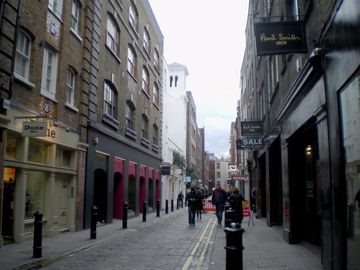

If the street name encouraged you to expect a beautiful street of flowers, you'll be disappointed – Floral Street has no flowers at all. It only received the name in 1895 by town planners – it had previously been called Harte Street – and the name was supposed to commemorate the Covent Garden area's tradition for selling flowers. In reality Harte Street was mostly known for selling fruit, and sex – in fact it was the main street where Covent Garden's 18th century brothels were located. The rebuilding of the area in the 1980s changed the image of the street entirely, and now we find high-end men's fashion shops here, including the famous British designer Paul Smith.
Walk to the far end of Floral Street to the junction with the tiny and atmospheric alley of Rose Lane. Here you'll find one of London's oldest historic pubs, the Lamb & Flag, which has been serving ale in the Covent Garden area since 1772. A sign outside the pub mentions a nasty attack on a 17th century poet which took place in this dark alley: “On the 19th December 1679 in the alley by the Lamb & Flag, the poet John Dryden was nearly done to death by rogues hired by the Earl of Rochester”. Not all writers have been treated so badly here – two hundred years later the Lamb & Flag was a favorite tavern where Charles Dickens used to meet Wilkie Collins (at that time the pub was known as The Cooper's Arms). Floral Street continues on the other side of James Street too, where celebrity-spotters might see stars going in at the Stage Door of the Royal Opera House. In the 18th century, Floral Street was the regular meeting place for another group of gentlemen – it was the main street in London where gay men might meet each other, and a special brothel here catered to their needs. A popular ballad of the time wrote about Floral Street:
Oh ain't it just a blessed shame, men blind to women's charms?
Ignoring the beauties hereabouts, they swoon into male arms!